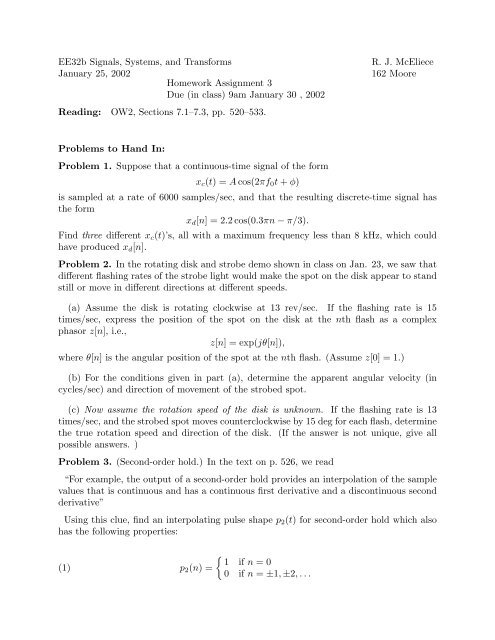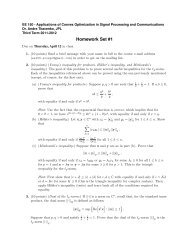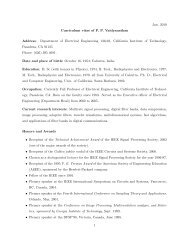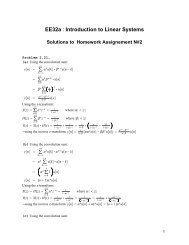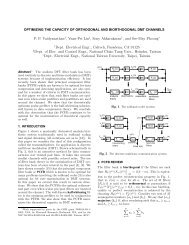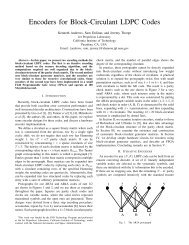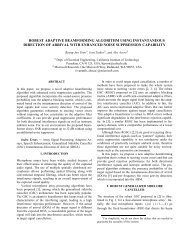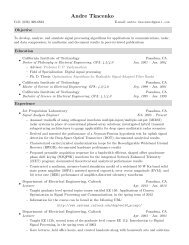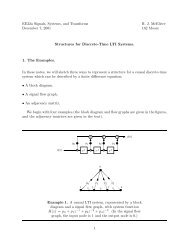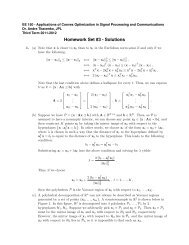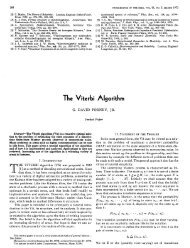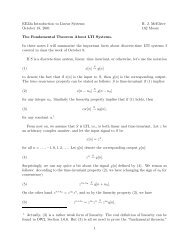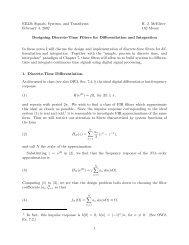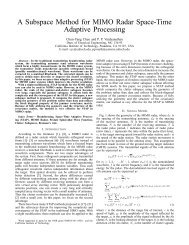Homework Assignment 3
Homework Assignment 3
Homework Assignment 3
Create successful ePaper yourself
Turn your PDF publications into a flip-book with our unique Google optimized e-Paper software.
EE32b Signals, Systems, and Transforms<br />
January 25, 2002<br />
<strong>Homework</strong> <strong>Assignment</strong> 3<br />
Due (in class) 9am January 30 , 2002<br />
Reading: OW2, Sections 7.1–7.3, pp. 520–533.<br />
R. J. McEliece<br />
162 Moore<br />
Problems to Hand In:<br />
Problem 1. Suppose that a continuous-time signal of the form<br />
x c (t) =A cos(2πf 0 t + φ)<br />
is sampled at a rate of 6000 samples/sec, and that the resulting discrete-time signal has<br />
the form<br />
x d [n] =2.2 cos(0.3πn − π/3).<br />
Find three different x c (t)’s, all with a maximum frequency less than 8 kHz, which could<br />
have produced x d [n].<br />
Problem 2. In the rotating disk and strobe demo shown in class on Jan. 23, we saw that<br />
different flashing rates of the strobe light would make the spot on the disk appear to stand<br />
still or move in different directions at different speeds.<br />
(a) Assume the disk is rotating clockwise at 13 rev/sec. If the flashing rate is 15<br />
times/sec, express the position of the spot on the disk at the nth flash as a complex<br />
phasor z[n], i.e.,<br />
z[n] =exp(jθ[n]),<br />
where θ[n] isthe angular position of the spot at the nth flash. (Assume z[0] = 1.)<br />
(b) For the conditions given in part (a), determine the apparent angular velocity (in<br />
cycles/sec) and direction of movement of the strobed spot.<br />
(c) Now assume the rotation speed of the disk is unknown. If the flashing rate is 13<br />
times/sec, and the strobed spot moves counterclockwise by 15 deg for each flash, determine<br />
the true rotation speed and direction of the disk. (If the answer is not unique, give all<br />
possible answers. )<br />
Problem 3. (Second-order hold.) In the text on p. 526, we read<br />
“For example, the output of a second-order hold provides an interpolation of the sample<br />
values that is continuous and has a continuous first derivative and a discontinuous second<br />
derivative”<br />
Using this clue, find an interpolating pulse shape p 2 (t) for second-order hold which also<br />
has the following properties:<br />
(1) p 2 (n) =<br />
{<br />
1 if n =0<br />
0 if n = ±1, ±2,...
(2) p 2 (t) =0for|t| ≥2.<br />
(3) p 2 (t) ispiecewise quadratic.


